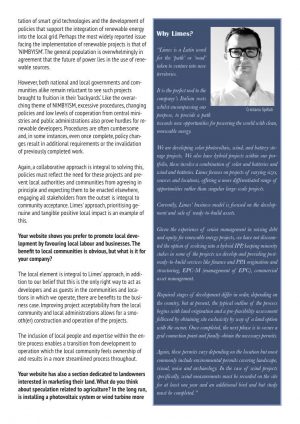 Cristiano Spillati is a renewable energy entrepreneur. As the Managing Director of Limes Renewable Energy, he explains the significance of collaboration and dialogue in renewable energy projects and their profound impact on communities.
Cristiano Spillati is a renewable energy entrepreneur. As the Managing Director of Limes Renewable Energy, he explains the significance of collaboration and dialogue in renewable energy projects and their profound impact on communities.
How does the Limes contribute to the energy transition?
We are developing renewable energy projects at the highest technical standards. Mitigating potential negative local impacts and creating positive spill-over effects into the local community is at the heart of the Limes approach and sets us apart from other developers. We also have a strong focus on agrivoltaics projects, combining crop cultivation and electricity production, addressing the issue of agricultural land use by conventional solar PV projects.
You deal with renewable energy, solar and wind, and energy storage. What storage projects have you developed? What type of batteries do you create?
Currently, Limes has a pipeline of 550MW in Italy and 400MW in Chile, our projects are still in the development phase. Unlike in the UK, in the markets in which Limes is involved, storage is in its infancy. In many areas regulations around battery storage have been very recently defined or are still in the process of definition. At present Limes is focused on lithium-ion batteries.
What are the most significant hurdles you encounter in developing a project?
Limes prides itself on our ability to identify and successfully develop renewable projects, but the process is not simple. Our extensive knowledge and expertise in the sector and across the markets in which we operate allow us to navigate a number of challenges associated with the development of renewables.
Primarily, there are difficulties prior to the development phase of a project, in acquiring the location. Suitable land is scarce and the competition for this land is extremely strong. Aside from this aspect of competition, this demand naturally affects the price of land and therefore acquiring land at a reasonable price is a challenge.
Similarly, grid congestion poses another challenge, insufficient capacity in the transmission network to accommodate the power generated by new renewable projects can limit the profitability of proposed projects or require additional investment in the local network to allow for more reliable and consistent access to the grid.
These difficulties can be mitigated by a coordinated effort to expand and upgrade infrastructure with the implementation of smart grid technologies and the development of policies that support the integration of renewable energy into the local grid. Perhaps the most widely reported issue facing the implementation of renewable projects is that of ‘NIMBYISM’. The general population is overwhelmingly in agreement that the future of power lies in the use of renewable sources.
However, both national and local governments and communities alike remain reluctant to see such projects brought to fruition in their ‘backyards’. Like the overarching theme of NIMBYISM, excessive procedures, changing policies and low levels of cooperation from central ministries and public administrations also prove hurdles for renewable developers. Procedures are often cumbersome and, in some instances, even once complete, policy changes result in additional requirements or the invalidation of previously completed work.
Again, a collaborative approach is integral to solving this, policies must reflect the need for these projects and prevent local authorities and communities from agreeing in principle and expecting them to be enacted elsewhere, engaging all stakeholders from the outset is integral to community acceptance. Limes’ approach, prioritising genuine and tangible positive local impact is an example of this.
Your website shows you prefer to promote local development by favouring local labour and businesses. The benefit to local communities is obvious, but what is it for your company?
The local element is integral to Limes’ approach, in addition to our belief that this is the only right way to act as developers and as guests in the communities and locations in which we operate, there are benefits to the business case. Improving project acceptability from the local community and local administrations allows for a smooth(er) construction and operation of the projects.
The inclusion of local people and expertise within the entire process enables a transition from development to operation which the local community feels ownership of and results in a more streamlined process throughout.
Your website has also a section dedicated to landowners interested in marketing their land. What do you think about speculation related to agriculture? In the long run, is installing a photovoltaic system or wind turbine more convenient than farming the land?
Agri-PV offers a dual land use opportunity, maximising land efficiency by allowing crop cultivation, livestock grazing, beekeeping activities, and generating additional revenue through renewable energy. A coherent and effective agri-PV project integrates renewable energy with agricultural production, creating a value greater than the sum of its parts. We collaborate with landowners, local agronomists, agri-PV consultancies, and social cooperatives to ensure site-specific solutions for both electricity production and land cultivation. Analyses show that converting less than 1% of Italy’s agricultural land to agri-PV could meet 2030 targets without compromising agricultural production in any way.
Effective management of agri-PV projects is integral for ensuring the success of both renewable energy generation and agricultural productivity, offering landowners a unique dual-use opportunity. If these projects are well developed and implemented the perceived conflict between renewable energy and agricultural land use is non-existent. As an English farmer involved in an agrivoltaics project on his land once said, “It’s not about producing 10 units of energy or 10 units of food. It could even be six units of each. But then we might discover that the two halves are greater than the whole.”
In your experience, what are the requirements for developing agro-photovoltaic systems, including from an environmental and landscape perspective, to obtain project approval?
As with all projects, these requirements will differ from country to country. Currently, within Italy, in which Limes has considerable experience, projects must ensure that a minimum of 70% of the land is maintained for crop cultivation and that the economic value generated by crop production is also maintained.
Additionally, the electricity produced by the Agri-PV project must represent at least 60% of a standard photovoltaic project. Finally, the area occupied by the solar panels must account for no more than 40% of the total land area of the project.
Is there an obligation for monitoring and control in other countries to prove the continuity of the agricultural/pastoral activity?
Currently, Limes is exclusively developing Agri-PV projects in Italy where monitoring is becoming increasingly important. We expect monitoring to become mandatory for all types of Agri-PV projects globally in the future, as is the case in Italy for advanced projects to access incentives.
How do you see the development of the renewable energy sector in Italy, and what are you doing to meet the new challenges?
Italy has been too slow to develop renewable energy strategies and projects in comparison to other European countries, to date. The current commitment to meet EU targets by 2030, and the dire economic sanctions that will follow if Italy fails to do so, must motivate to act quickly and with purpose. Italy is subject to the same stalling and slowing as many other countries as possible in Europe, policies are watered down, deadlines are extended and targets are left unmet, with constantly changing priorities and no tangible commitment to action. Italy, along with much of Europe needs sufficient political will to progress the energy transition at the speed required to meet EU targets.
What trends in the renewable energy sector could impact your company?
Fortunately, technological advancements and trends are in our favour, as technology in the sector continues to improve and create efficiencies, becoming more widespread and gradually these technologies become cheaper to access. Trade restrictions could negatively affect the cost of electricity produced by renewable energy, making it more expensive, we are seeing evidence of this in the US, where public incentives have become necessary to compensate for import duties on equipment from China to maintain the economic viability of projects.
More generally, the development and implementation of large-scale renewable energy projects is very capital intensive and so the high cost of debt poses a risk. These uncertainties contribute to the reasoning behind Limes’ portfolio approach, developing a range of projects of varying sizes and in varied geographies enables us to adapt to changing circumstances and remain flexible in our approach to development.
Alice Masili





